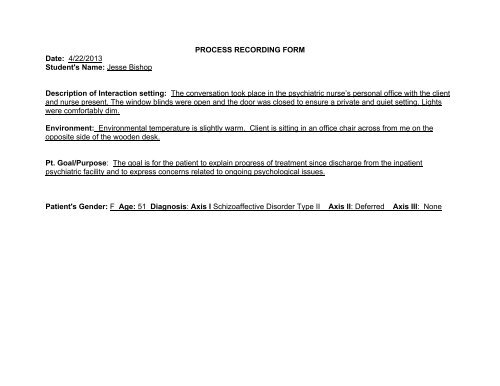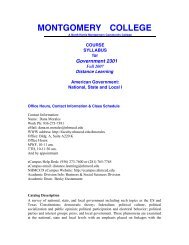Process Recording Form - Communication Across the Curriculum ...
Process Recording Form - Communication Across the Curriculum ...
Process Recording Form - Communication Across the Curriculum ...
- No tags were found...
You also want an ePaper? Increase the reach of your titles
YUMPU automatically turns print PDFs into web optimized ePapers that Google loves.
Date: 4/22/2013Student's Name: Jesse BishopPROCESS RECORDING FORMDescription of Interaction setting: The conversation took place in <strong>the</strong> psychiatric nurse’s personal office with <strong>the</strong> clientand nurse present. The window blinds were open and <strong>the</strong> door was closed to ensure a private and quiet setting. Lightswere comfortably dim.Environment: Environmental temperature is slightly warm. Client is sitting in an office chair across from me on <strong>the</strong>opposite side of <strong>the</strong> wooden desk.Pt. Goal/Purpose: The goal is for <strong>the</strong> patient to explain progress of treatment since discharge from <strong>the</strong> inpatientpsychiatric facility and to express concerns related to ongoing psychological issues.Patient's Gender: F Age: 51 Diagnosis: Axis I Schizoaffective Disorder Type II Axis II: Deferred Axis III: None
COLUMN-1 COLUMN-2 COLUMN-3 COLUMN-4 COLUMN-5 COLUMN-6Student’s verbalstatements(exact quotes)Student’s nonverbalbehaviorClient’s verbalstatements(exact quotes)Client’s non-verbalbehavior“Hi, my name isJesse Bishop and Iam a nursingstudent at Lone StarCollege –Montgomery. Howare you feelingtoday?”Relaxed and openposture, legsuncrossed, leaningtowards client.,maintaining eyecontact.“Oh, I guess I’mdoing okay. Justfollowing up since Iwas hospitalized.”Arms crossed atchest, looking at wallto her right, rapidlyand rhythmicallytapping right foot.<strong>Communication</strong>technique used.DesignateFacilitators (F) OR(B) Barrier and name<strong>the</strong> type(F) – “Givinginformation”(Videbeck, 2011, p .103).Evaluation (asdescribed intextbook)and/orRevisionGiving informationbuilds trust with <strong>the</strong>client and allows <strong>the</strong>client to know whatto expect during acommunicationsession.“Alright. I noticedthat you are tappingyour foot. Are youanxious aboutsomething?”“Okay. Is <strong>the</strong>reanything inparticular that youfeel you need to talkabout today?”Relaxed and openposture, legsuncrossed, leaningtowards client,maintaining eyecontact.Relaxed and openposture, legsuncrossed, leaningtowards client,maintaining eyecontact.“No, it’s just hard forme to sit still. I’malways on <strong>the</strong>move.”“Umm, I don’t know.Sometimes I just feellike I’m losingcontrol of myself.”Arms crossed,maintaining eyecontact, rapidly andrhythmically tappingright foot.Arms folded in lap,maintaining eyecontact, rapidly andrhythmically tappingright foot.(F) – “Makingobservations”(Videbeck, 2011, p .103).(F) – “Broadopenings”(Videbeck, 2011, p .102).Allows clients toverbalize feelings or“make <strong>the</strong>mselvesbetter understood”(Videbeck, 2011, p . 103).Also encouragesclients to talkBroad openingsencourage <strong>the</strong> clientto take <strong>the</strong> leadwithin <strong>the</strong>conversation,especially when <strong>the</strong>client is hesitant(Videbeck, 2011).
“You feel like youare not always incontrol of yourself?”“What were <strong>the</strong>events that led up toyourhospitalization?”Relaxed and openposture, legsuncrossed, leaningtowards client,maintaining eyecontact.Relaxed and openposture, legsuncrossed, leaningtowards client,maintaining eyecontact.“Yeah, I’ve felt thatway since a fewweeks before I wasput in <strong>the</strong> psychward.”“Well, my boyfriendand I started fightinga lot until I finallytried to kill him.”Arms folded in lap,looking at wall to herright and <strong>the</strong> ceiling,rapidly andrhythmically tappingright foot.Arms crossed atchest, maintainingeye contact, legscrossed.(F) – “Restating”(Videbeck, 2011, p .103).(F) – “Placing event intime or sequence”(Videbeck, 2011, p .103).Allows client toknow whe<strong>the</strong>r or not“<strong>the</strong>y effectivelycommunicated <strong>the</strong>irideas andencourages <strong>the</strong>m tocontinue” (Videbeck,2011, p . 103).Helps <strong>the</strong> “nurseand <strong>the</strong> client seeevents inperspective”(Videbeck, 2011, p . 103).and recognizetrends regardingcause-and-effectbehavior.
“Why did you try tokill your boyfriend?”Tense but openposture, legsuncrossed, leaningtowards client,looking down atdesk.“He just made meso angry and I justhad it in my mindthat that was <strong>the</strong>right thing to do. Henever seemed likehe wanted mearound and I wasn’tgoing to see himwith anyone else ifwe split up. I had <strong>the</strong>chainsaw in myhands andeverything until afriend of minestopped me. Ipromise you I wasgoing to kill him. Itwas definitely goingto be a bloodbath.”Arms folded in lap,looking down athands andoccasionallyestablishing eyecontact, legsuncrossed, rapidlyand rhythmicallytapping right foot.(B) – “Requesting anexplanation”(Videbeck, 2011, p .106).Requesting anexplanation with a“why” question maymake <strong>the</strong> client feellike <strong>the</strong>y need todefend <strong>the</strong>mselves(Videbeck, 2011).Revision:“How do you feelabout your attemptat killing yourboyfriend?”
COLUMN-1 COLUMN-2 COLUMN-3 COLUMN-4 COLUMN-5 COLUMN-6Student’s verbalstatements(exact quotes)Student’s nonverbalbehaviorClient’s verbalstatements(exact quote)Client’s non-verbalbehavior<strong>Communication</strong>technique used.Designate Facilitators(F) OR (B) Barrier andInterpretationAnd/orRevision“Before thisincident, had youever felt this kind ofanger before?”“So, what do youthink you could doin <strong>the</strong> future to avoidtrying to kill him if hemakes you thatangry again?”Relaxed and openposture, maintainingeye contact, legsuncrossed, leaningtowards client.Relaxed and openposture, maintainingeye contact, legsuncrossed, leaningtowards client.“Actually, he’s mademe that angry plentyof times before but Ijust never acted on ituntil <strong>the</strong>n.”“Oh, I’m not sure. Ireally don’t plan onever seeing himagain, but I guess I’dprobably go to afriend’s house until Iwas able to calmdown and think alittle more clearly.That’s what I used todo before.”Arms folded in lap,head down andlooking at hands,feet and legs still.Arms folded in lap,maintaining eyecontact, feet andlegs still.name <strong>the</strong> type(F) –“Encouragingcomparison” (Videbeck,2011, p . 102)(F) –“<strong>Form</strong>ulating a planof action” (Videbeck,2011, p . 102)Comparisons of pastideas and experiencesencourage clients tothink about effectivecoping mechanismsutilized in similarsituations.<strong>Form</strong>ulating a plan ofaction increases <strong>the</strong>likeliness of <strong>the</strong> clienteffectively coping withsimilar situations in<strong>the</strong> future (Videbeck,2011).
“I think that might bea good plan.”Relaxed and openposture, maintainingeye contact, legsuncrossed, leaningtowards client.“Yeah, it might keepme out of trouble.”Arms crossed atchest, maintainingeye contact, rapidlyand rhythmicallytapping right foot.(B) – “Agreeing”(Videbeck, 2011, p .105).Agreeing with <strong>the</strong>client prevents <strong>the</strong>mfrom being able tochange <strong>the</strong>ir mindabout <strong>the</strong>ir decisionwithout feeling like<strong>the</strong>y are wrong(Videbeck, 2011).“Can you think ofany o<strong>the</strong>r ways thatmight help you copewith youremotions?”Open and relaxedposture, maintainingeye contact, legsuncrossed, leaningtowards client.“Well, <strong>the</strong> doctorchanged mymedicine around, soI’m hoping that’llhelp me deal withmy problems. O<strong>the</strong>rthan that, I don’tthink so.”Arms folded in lap,maintaining eyecontact, feet flat on<strong>the</strong> floor and legsare still.(F) –“<strong>Form</strong>ulating a planof action” (Videbeck,2011, p .102).Revision:“Has that worked foryou in <strong>the</strong> past?”<strong>Form</strong>ulating a plan ofaction increases <strong>the</strong>likeliness of <strong>the</strong> clienteffectively coping withsimilar situations in<strong>the</strong> future (Videbeck,2011).
“Okay. So, in <strong>the</strong>past few minutes wehave talked aboutalternative ways todeal with yourchanging moods,including takingyour medication asprescribed andstaying away fromyour boyfriend whenyou become angry.Is <strong>the</strong>re anythingyou would like toadd?”“You’re welcome.Remember to callthis clinic or <strong>the</strong>crisis hotline if youfeel like youremotions arebecoming toooverwhelming. Thecrisis hotline isavailable 24/7. Havea good day!”Open and relaxedposture, maintainingeye contact, sittingup straight.Standing,maintaining eyecontact, armsrelaxed at sides.“No, I think that’s it. Iactually feel a littlebetter now that I’vebeen able to vent toyou. Thanks.”“Thank you somuch! I alwaysforget about <strong>the</strong>crisis hotline.”Arms at sides,maintaining eyecontact, smiling, feetflat on <strong>the</strong> floor andlegs are still.Standing,maintaining eyecontact, armsrelaxed at sides.(F) – “Summarizing”(Videbeck, 2011, p . 104).(F) – “Givinginformation” (Videbeck,2011, p . 103).Summarizinghighlights <strong>the</strong>important pieces of<strong>the</strong> conversation andeliminates <strong>the</strong>irrelevant informationdiscussed.Summarizing alsohelps organize <strong>the</strong>discussion as well asprovide a closure to<strong>the</strong> conversation(Videbeck, 2011).“The nurse functionsas a resource person”(Videbeck, 2011, p . 103).Giving informationbuilds trust with <strong>the</strong>client.ReferenceVidebeck, S. L. (2011). Psychiatric-Mental Health Nursing (5th ed.). Philadelphia, PA: Wolters Kluwer/Lippincott Williams& Wilkins.
Overall Self Evaluation:The process recording performed during <strong>the</strong> psychiatric rotation was startling, yet pleasantly different in context aswell as content. I feel like I have greatly improved my communication skills and streng<strong>the</strong>ned my <strong>the</strong>rapeuticcommunication since <strong>the</strong> completion of my last process recording. Although some of <strong>the</strong> client’s comments took me bysurprise, I believe I reacted well and adapted fairly quickly to <strong>the</strong> situation. I believe my strengths involve understanding<strong>the</strong> client’s condition and how it may affect <strong>the</strong>ir thinking and behavior. I believe my weaknesses involve trying to relate to<strong>the</strong> client on a more casual level as well as visibly reacting to somewhat shocking statements made by <strong>the</strong> client. Duringmy psychiatric rotation, I learned great information about fairly common mental disorders. In completing my processrecording, I realized how easily emotions, and even mental disorders, can be overlooked and confused with behavioralissues. As a society, we must recognize <strong>the</strong>se types of disorders within our community and be able to accommodate <strong>the</strong>mentally ill accordingly. Overall, I believe this experience has enlightened me and allowed me to think more deeply about<strong>the</strong> causes of people’s behaviors instead of solely focusing on <strong>the</strong> behaviors <strong>the</strong>mselves.






